1. Fe-based nanocrystalline soft magnetic materials
Nanocrystalline
soft magnetic materials consist of ultra-fine ferromagnetic
crystallites with size of approximately 10 nm. Owing to strong
ferromagnetic exchange coupling between the nanocrystallites, their
magnetocrystalline anisotropy is averaged out and the materials exhibit
good soft magnetic properties (Fig. 1).
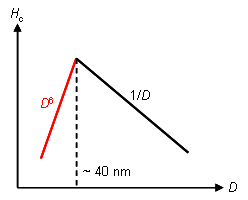
Fig. 1 Relationship between crystalline size (
D) and coercivity (
Hc)
We are
investing the microstructure and the magnetic properties of the
nanocrystalline Fe-M-B (M = Zr, Hf, Nb) soft magnetic alloys. The
nanocrystalline alloys are produced by the crystallizing the melt-spun
(Fig. 2) amorphous phase (Fig. 3). The resultant alloys have a mixed
structure consist of nanoscale ¿-Fe phase (crystalline size is approximately 10 nm)
embedded in a ferromagnetic amorphous matrix (Fig. 4). The
nanocrystalline Fe-M-B (M = Zr, Hf, Nb) soft magnetic alloys exhibit
the high permeability as well as the high saturation magnetic flux
density (Fig. 5).
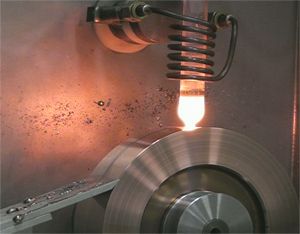
Fig. 2 Melt-spinning apparatus
(Please click the photograph to play the movie.
Windows Media Player is required.)
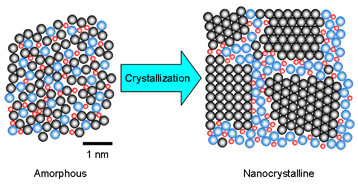
Fig. 3 Schematic image of nanocrystallization
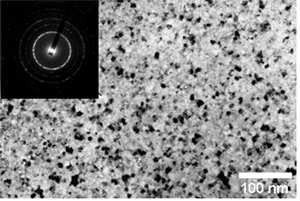
Fig. 4 TEM image of nanocrystalline Fe-Nb-B alloy
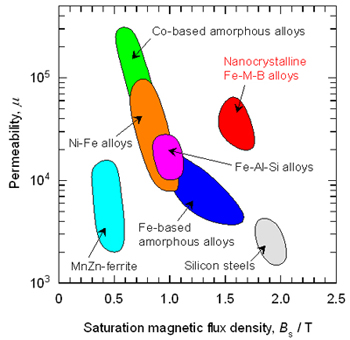
Fig. 5 Relationship between saturation magnetic flux density (
Bs) and permeability (
Ê)
Related Publications
- T. Bitoh, A. Makino and A. Inoue, gThe Effect of Grain-Size Distribution on Coercivity in Nanocrystalline Soft Magnetic Alloys,h Journal of Magnetism and Magnetic Materials, vols. 272–276, pp. 1445–1446 (2004).
- T. Bitoh, A.
Makino, A. Inoue and T. Masumoto, gRandom Anisotropy Model for
Nanocrystalline Soft Magnetic Alloys with Grain-Size Distribution,h
Materials Transactions, vol. 44, no. 10, pp. 2011–2019 (2003).
2. Fe-(Pt, Pd)-based nanocrystalline hard magnetic materials
The ordered L10 alloys (Fig. 6)
such as Fe-Pt, Co-Pt, Fe-Pd have long been anticipated as materials for
permanent magnets because of their large magnetocrystalline anisotropy
and good corrosion resistance. However, near equiatomic FePt cast
alloys do not exhibit high magnetic hardness because of their
coarsening structure.
We are investing the microstructure and the magnetic properties of the
nanocrystalline (Fe, Pt)-M-B (M = Zr, Hf, Ti) hard magnetic alloys. The
simultaneous addition of transition metals and B to the Fe-Pt alloy
remarkably decreases its melting temperature. The L10-FePt phase with a size of approximately 100 nm can be directly synthesized (Fig. 7) by rapidly quenching of the melt (Fig. 2)
without allowing the formation of the disordered fcc phase, and the
high coercivity of 688 kA/m, which is much higher than that of the
annealed bulk Fe-Pt, is obtained for the melt-spun (Fe0.50Pt0.50)78Zr4B18 alloy in an as-quenched state (Fig. 8).
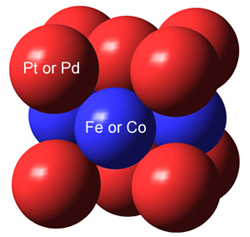
Fig. 6 Unit cell of L1
0 ordered alloys
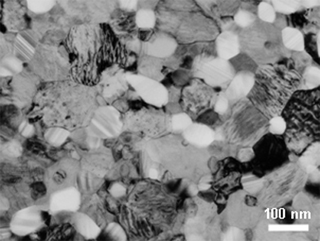
Fig. 7 TEM image of nanocrystalline Fe-Pt-Zr-B alloy
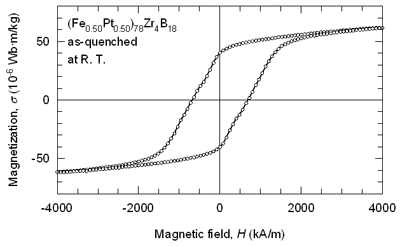
Fig. 8 Magnetization curve of melt-spun Fe-Pt-Zr-B alloy in an as-quenched state
Related Publications
- T. Bitoh, M.
Nakagawa and A. Makino, gMelting Temperature and Order-Disorder
Transformation of Melt-Spun (Fe, Pt)-Zr-B Nanocrystalline Alloys,h
Scripta Materialia, vol. 53, no. 4, pp. 429–434 (2005).
- T. Bitoh, A.
Makino and M. Nakagawa, gMicrostructure and Hard Magnetic Properties of
Directly Synthesized L10 (Fe1–xPtx)78Zr4B18 Nanocrystalline Alloys by
Melt-Spinning,h Journal of Applied Physics, vol. 97, no. 10, 10H307
(2005) (3 pages).
3. Fe-based bulk metallic glasses
Recently, a number of amorphous alloys exhibit a wide supercooled liquid region (¢Tx)
before crystallization. The appearance of the wide supercooled liquid
region implies that the alloys have high resistance against
crystallization. Consequently, these alloys with large ¢Tx
values have been confirmed to have an extremely large glass-forming
ability, which enables the production of bulk metallic glasses (Fig. 9).

Fig. 9 Fe-based bulk metallic glasses produced by Cu-mold casting
It is
well know that Fe- and Co-based ordinary amorphous alloys exhibit good
soft magnetic properties. The origin of the good soft magnetic
properties is lack of long-range atomic order (the left figure in Fig. 3).
This feature is also common in the bulk metallic glasses. It seems that
therefore, the soft magnetic properties of the bulk metallic glasses
are same as those of the ordinary amorphous alloys. Is this assumption
correct?
We are investing the magnetic properties of the Fe-based bulk metallic
glasses. The bulk metallic glasses exhibit lower coercivity (Hc) than that of the ordinary amorphous alloys (Fig. 10). The low Hc originates from the much higher packing density of the bulk metallic glasses
than that of the ordinary amorphous alloys, which realizes the low
density of the pinning centers for magnetic domain-walls. The good
combination of high glass-forming ability and good soft magnetic
properties indicates the possibility of future development as a new
bulk glassy soft magnetic material.
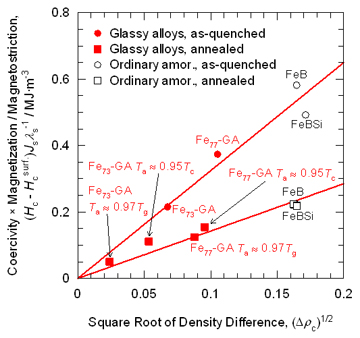
Fig. 10 Relationship between density (
Ï) and coercivity (
Hc) of Fe-based bulk metallic glasses and ordinary amorphous alloys
Related Publications
- T. Bitoh, A.
Makino and A. Inoue, gOrigin of Low Coercivity of
(Fe0.75B0.15Si0.10)100–xNbx (x = 1–4) Glassy Alloys,h Journal of
Applied Physics, vol. 99, no. 8, 08F102 (2006) (3 pages).
- T. Bitoh, A.
Makino and A. Inoue, gMagnetization Process and Coercivity of Fe-(Al,
Ga)-(P, C, B, Si) Soft Magnetic Glassy Alloys,h Materials Transactions,
vol. 45, no. 4, pp. 1219–1227 (2004).
- T. Bitoh, A.
Makino and A. Inoue, gOrigin of Low Coercivity of Fe-(Al, Ga)-(P, C, B,
Si, Ge) Bulk Glassy Alloys,h Materials Transactions, vol. 44, no. 10,
pp. 2020–2024 (2003).
The Fe-(Co, Ni) based bulk metallic glasses exhibit good soft magnetic properties, described above. However, the glass-forming ability of the soft magnetic bulk metallic glasses
is inferior to that of the nonferrous alloys such as Pd-, Zr-,
lanthanide-, and Mg-based alloys. It is well known that the main
competition to prepare bulk metallic glasses
is attributed to oxides and other inclusion in the molten metal which
act as heterogeneous nucleation sites for crystallization. An approach
to eliminate the inclusions is to heat and cool the molten metal while
it is immersed in molten oxide flux. Recently, we have succeeded in the
synthesis of the large soft magnetic [(Fe0.5Co0.5)0.75B0.20Si0.05]96Nb4 bluk metallic glass specimens with the diameters up to 7.7 mm by water quenching the melt immersed in the molten flux of B2O3 (Fig. 11).
The maximum diameter of the obtained specimens is approximately 1.5
times as large as the previous result for copper mold casting. This
bulk specimen is the thickest of any soft magnetic bulk metallic glasses formed until now.
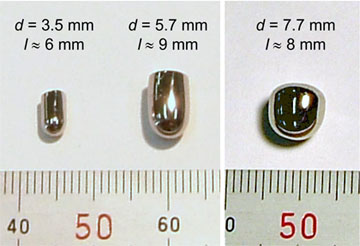
Fig. 11 Soft magnetic
bulk metallic glasses prepared by B
2O
3 flux melting and water quenching technique
Related Publications
- T. Bitoh, A.
Makino, A. Inoue and A. L. Greer, gLarge Bulk Soft Magnetic
[(Fe0.5Co0.5)0.75B0.20Si0.05]96Nb4 Glassy Alloy Prepared by B2O3 Flux
Melting and Water Quenching,h Applied Physics Letters, vol. 88, no. 18,
182510 (2006) (3 pages).
- T. Bitoh, A.
Makino, A. Inoue and A. L. Greer, gFormation of Large Bulk
[(Fe0.5Co0.5)0.75B0.20Si0.05]96Nb4 Glassy Alloy by Flux Melting and
Water Quenching,h Materials Research Society Symposium Proceedings,
eds. E. Ma, S. Schuh, Y. Li and M. K. Miller (Boston, Materials
Research Society, 2006) vol. 903E, Z05–18 (6 pages).
Go to: Top of my home page
Last modified on March 28th, 2019











